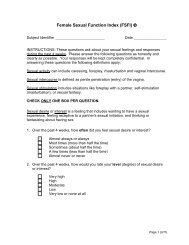The Female Sexual Function Index (FSFI): A Multidimensional Self ...
The Female Sexual Function Index (FSFI): A Multidimensional Self ...
The Female Sexual Function Index (FSFI): A Multidimensional Self ...
Create successful ePaper yourself
Turn your PDF publications into a flip-book with our unique Google optimized e-Paper software.
<strong>Female</strong> <strong>Sexual</strong> <strong>Function</strong> <strong>Index</strong><br />
Factor Analysis and Domain Scoring<br />
A principal components analysis (using varimax rotation) was performed to<br />
investigate the factor structure of the 29-item questionnaire. This analysis<br />
was performed using Visit I data for the total group (N = 259) as well as<br />
separately for the FSAD subgroup (N = 128) and controls (N = 131). Four<br />
factors with eigenvalues over 1.00 were identified for all three samples; however,<br />
a five-factor solution with the FSAD group yielded the most consistent<br />
pattern of factor loadings. <strong>The</strong> fifth factor had an eigenvalue high enough to<br />
justify inclusion.<br />
<strong>The</strong> selection of items for each factor was determined on the basis of a<br />
combination of the following statistical and clinical considerations. Statistical<br />
criteria for item inclusion included high/moderate loading on one factor, low<br />
cross-factor loading, high/moderate test-retest reliability, and good discrimination<br />
between the FSAD and the control sample. While all of the items<br />
were satisfactory to very satisfactory on these criteria, a refinement of the full<br />
scale through item reduction was conducted for the goal of minimizing redundancy<br />
and creating a briefer instrument. Four questions relating to “pleasurable<br />
feelings” of warmth and tingling were eliminated because there could<br />
be some ambiguity in defining these terms (they also showed more factor<br />
cross-loading than other items). A question about “satisfaction with amount<br />
of stimulation from partner” was dropped since three good satisfaction items<br />
were already available. Additionally, the five compound (two-part) questions<br />
which related to “distress” were dropped from further consideration<br />
due to their dependence on sexual activity and resultant complications in<br />
interpretation and scoring. All subsequent analyses were performed on the<br />
19-item questionnaire resulting from this item reduction process.<br />
In order to assess the impact of choosing the response choice of “no<br />
sexual activity,” a factor analysis was performed excluding data from the 13<br />
subjects in the FSAD group and 3 subjects in the control group who reported<br />
that they had no sexual activity within the past month. Since a pattern of<br />
factor results was obtained that was very similar to that described below for<br />
the complete sample, further analyses were performed with all study subjects<br />
included.<br />
Based on the results of the factor analysis of the 19-item questionnaire<br />
using the complete sample, individual items were assigned to five separate<br />
domains of female sexual function: desire/arousal, lubrication, orgasm, satisfaction,<br />
and pain. <strong>The</strong> pattern of factor loadings was similar for the total<br />
group and the FSAD group alone. <strong>The</strong> pattern was less clear for the control<br />
sample alone. In this group, for example, one factor was comprised of a mix<br />
of lubrication and arousal items, and another consisted of a mix of arousal<br />
and orgasm items. Table 2 presents the confirmatory factor analysis results<br />
for the FSAD group. Items generally clustered in the predicted fashion and<br />
had relatively high factor loadings, supporting the factoral validity of the<br />
final questionnaire.<br />
197




